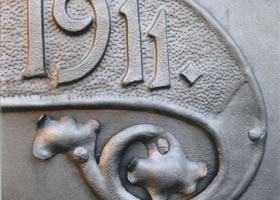Illa Raspall

The set of four isolated buildings that make up the space delimited by the Passeig and the streets Figueral, Caselles and Manuel J. Raspall is known as Illa Raspall. Of the six Raspall islands that, between 1906 and 1914, the eponymous architect built in La Garriga, this, chronologically the fourth, is the only one that has survived in its entirety to this day.
It is a unique ensemble in Catalan modernist architecture: four isolated buildings, designed by the same architect and within the same block of houses, built in a very short period of time (1910-1913) and very representative of the first stage modernist in which the work of Manuel J. Raspall is divided, the most interesting of his work.
In addition, the complex is located in an emblematic space of the town and exemplifies the radical transformations that, at the time of its construction, the center of La Garriga, its landscape, its territory and its society were experiencing. Illa Raspall is located 50 meters from the stairs that lead to the train station and right at the beginning of the main artery of Garriguen summer: the Passeig. It is therefore the culminating space of the great bourgeois expanse that would inevitably change the defining features of a traditionally agricultural environment.
The houses that make up Raspall Island are, in chronological order: the Barbey house, the Bombonera, the Iris tower and the Barraquer house. The first three were started in 1910 and the fourth, in 1912. Likewise, the Barbey house and the Barraquer house were promoted by prominent members of the Barcelona bourgeoisie, while the Bombonera and the Torre Iris (the only multi-family building on the island, with three homes) were built by Cecília Reig from Garriguena, with the aim of renting them out as a second residence.
All four buildings maintain an obvious stylistic unity, which is particularly highlighted by the unitary treatment of the garden fence, which is visible in the wall, the trencadís cladding (of the predominant color in each house), the wavy profiles that crown the walls and the whiplash of the bars and access portals, with omnipresent vegetal motifs.
The houses of Illa Raspall
Barbey House
It is the most important work of Manuel J. Raspall. From the outside, the roof, on four levels and with glazed tiles that draw geometric shapes, stand out above all, the large lookout tower, the laughing sundial on the south facade and the magnificent Sant Jordi de trencadís on the west facade, made by Lluís Bru. The building is always dominated by brown tones.
Inside, it stands out for its grandeur, wealth of spaces and decorative elements: plinths, skirting boards, columns, plasterwork, paintings, mosaics, leaded stained glass windows... And the salamander-fireplace in the hall on the first floor is fantastic and the fireplace in the dining room, both with important trencadís work and the latter also with beautiful wrought iron details and a large coat of arms of Catalonia accompanied by Verdaguerian references.
The Bomboniera
Apart from the predominance of greenish tones, the precious sgraffitos with floral motifs, the careful woodwork in the bookcase blinds, the semicircular, elliptical and carpanel arches stand out - for the first time in the work de Raspall- and the beautiful lantern of iron and printed glass, as well as the gallery on the west facade.
Iris Tower
The exterior decoration of the house, always with yellowish tones, is particularly noteworthy for the sgraffitos and the details of the bars and the wrought iron work. On the north facade, the curved balcony takes on importance, the railing of which connects with the triangular balcony covered with trencadís on the upper floor.
Barraquer House
It is the least modernist building of the whole complex. The decorative details are much more contained than in the other houses, both in terms of the sgraffitos, as well as the details of the glazed ceramic buttons, as well as the forging or the facings of the facades. Even the fence is straight in profile and not wavy. At Casa Barraquer, bluish hues predominate, linking with the search for Mediterraneanness proposed by the already incipient Noucentisme.















